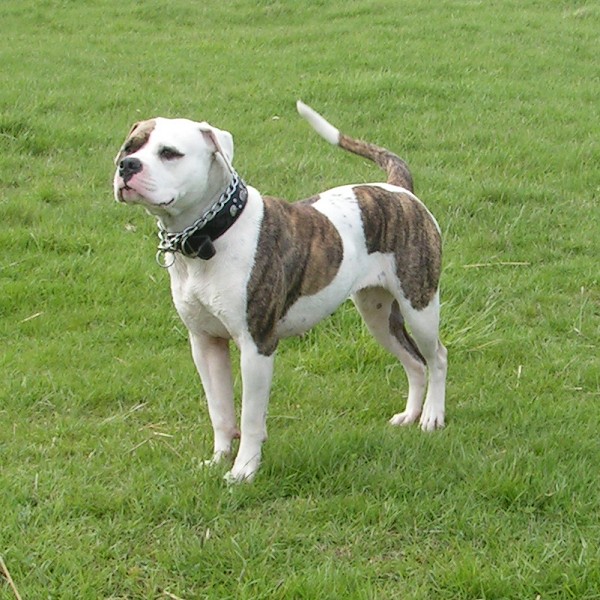- American Bulldog
Infobox Dogbreed

image_caption = A brindle and white American Bulldog
name = American Bulldog
altname = Old Country Bulldog
country =United States
ukcgroup = Guardian Dogs
ukcstd = http://www.ukcdogs.com/breeds/guardiandogs/americanbulldog.std.shtml
maleweight = 27-60 kg (75-125 lb)
femaleweight =
maleheight = 50-71 cm (20-28 in)
femaleheight =
coat = Short, harsh
color = Combinations of solid or degrees of white; all shades of brindle, brown, red, or tan
litter_size = 6-12 puppies
life_span = 8-15 yearsThe American Bulldog is a breed of domestic dog (Canis lupus familiaris). Though larger in size, they are the closest surviving relative of the
Old English Bulldog because they were not altered to as great an extent while inColonial America as their European cousins. There are generally considered to be two types of American Bulldog, the Johnson type and the Scott type, named after the breeders who were influential in developing them, John D. Johnson and Allen Scott. These are more commonly known as Classic or Bully type and Standard or Performance type.Description
Appearance
The American Bulldog is a stocky and well built, strong-looking dog. Its coat is short and either white, white with patches, black and white brindle, fawn and white, fawn and white brindle or a combination of all of these and some of them may even have what is called a blue patch. The color conformation is quite varied, but white must be somewhere in the coat for the dog to be confirmed in most ABD clubs. The Johnson type is a larger dog with a shorter muzzle than the Scott type. However, many modern American Bulldogs are a combination of the two types. In general, American Bulldogs weigh between 27 to 57 kg (60 to 125 lb) and are 52 to 70 cm (20 to 28 in) at the
withers but have been known to greatly exceed that.Confusion with other breeds
There are two distinct strains of American Bulldogs, Classic (Johnson, Bully) and Standard (Scott, Performance) which is often mistaken for its second cousin, the
American Pit Bull Terrier because of its appearance, and for its much smaller European relatives because of its name. The American Bulldog is different from any of these. The American Bulldog is massive in comparison to theFrench Bulldog orBulldog as it still resembles theOld English Bulldog and was never down bred to be alap dog .The Standard American Bulldog does resemble the
pit bull -type breeds on many points, such as being muscular dogs that can be all white or white with patches. However, thepit bull 's head is in the shape of a wedge coming to a more rounded point at the muzzle, whereas an American Bulldog's is box-shaped. The American Bulldog's ears are also typically uncropped, and its head is heavier and a little bulkier.Temperament
An American Bulldog is typically a happy, friendly, and assertive dog that is at ease with its family and fine with outsiders with whom the dog is acquainted. [ [http://www.trainpetdog.com/American-BullDog/about-american-bulldog.html "American BullDog: Origin, Temperament, Training, Exercise"] ] They are quite fond of children too. They bond strongly with their master and family but, because of strong guarding instincts and a somewhat dominant attitude, they should be socialized and obedience trained early to expose them to other dogs and people and to ensure that they can be controlled around company as they mature.
They are working dogs with high energy drives, and so American Bulldogs do best in a home with a large backyard and plenty of exercise. They are not always well behaved towards cats and smaller pets, but correct socialization at an early age can greatly increase the chances of them accepting these animals.
History
History in England
The history of
Mastiff -type dogs in the British Isles dates back beyond the arrival of Caesar. With the arrival of the Normans in 1066 cameAlaunt s from the continent. The breeding of the indigenous mastiffs to the newly arrived ones produced the Mastiff and Bulldog of England. An interesting aside is that all descriptions of the Alaunts (there were three types) mention an all white, or almost entirely white coat.In
England during the 17th and 18th centuries, Bulldogs were used on farms to hold livestock; as butchers' dogs; and as guardians, as well as for other tasks.Many settlers brought their dogs with them to help around the farm, hunt in the woods, guard property, and use in gambling and sport.In 1835, the sport of bull-baiting was outlawed in the
United Kingdom and, over time, theBulldog there became a common pet, being bred into today's more compact and complacent version. The product was as much the efforts of selectively bred bulldogs as it was the introduction of thePug . Conversely, the American strain maintained its utilitarian purpose, and thus underwent fewer modifications; even as its popularity declined in favor of other breeds. Even the slight modifications the bulldog underwent in England up to the Industrial Revolution (pre 1835), were absent in the American strain. (Most settlers of the American South came from the West Midlands and as a result of the Civil War between Royalists and Parliamentarians, well before the Industrial Revolution). Bulldogs in England were originally working dogs who drove and caught cattle and guarded their masters' property.History in the United States
The original Bulldog, however, was preserved by working class immigrants who brought their working dogs with them to the American South. Small farmers and ranchers used this all-around working dog for many tasks. By the end of World War II, however, the breed was almost extinct. Mr. John D. Johnson, a returning war veteran, decided to resurrect this breed. Along with Alan Scott and several other breeders, Johnson began carefully to breed American Bulldogs, keeping careful records and always with an eye for maintaining the breed's health and working abilities. The American Bulldog was recognized by the United Kennel Club on
January 1 1999 .
Wikimedia Foundation. 2010.
